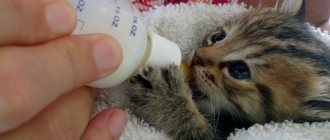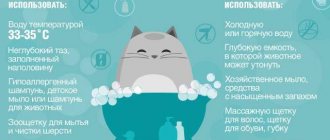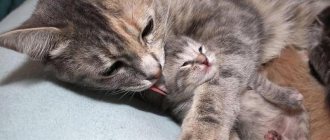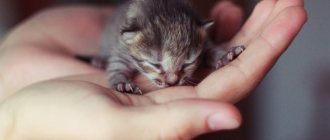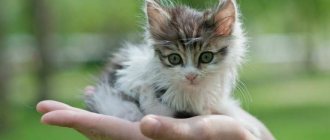If a kitten is left without a mother, its survival depends entirely on how well you organize its care. The ideal option is to find a surrogate cat mother for the baby who can feed the kitten (or kittens, if several were born). But this is not always possible. Therefore, if you are forced to cope on your own, the most important task should be to provide the kittens with food and warmth. Raising a kitten without a cat is quite possible, but you must understand that newborn kittens without a mother are very vulnerable, and you will need patience to care for them.
Equipment for a place for newborn kittens
First of all, blind kittens need to build a cozy “nest” in which they will be protected and warm, and, moreover, from which they will not be able to get out on their own, so as not to endanger their lives.
Kittens are cozy in a box
The simplest and most accessible option is a spacious cardboard box. Unlike metal, cardboard is warm, and if it goes bad, you can throw it away without regret and organize a more suitable house for the kids. Alternatively, you can use a plastic container. However, it should be understood that the ventilation in it will be worse, and besides, it must be washed and disinfected periodically.
In any case, having chosen a box, you still need to choose the right bedding for it. The simplest option would be a cotton fabric folded in several layers, on top of which you can lay a disposable absorbent diaper. To make the bed softer, you can lay a fleece blanket or terry towel. These are soft fabrics that are also warm and easy to clean.
Important! It is not recommended to cover a kitten house with woolen fabric. It may look attractive, but newborn kittens have a habit of sucking fur and can ingest it.
Maintaining thermal conditions
You need to equip a cozy house for kittens immediately, because it is important to warm the babies up as quickly as possible. When a mother cat is nearby, the kittens warm up by clinging to her warm side, but if the cat is not nearby, it is important to provide the babies with a temperature of around 20-22°C.
Therefore, as soon as you equip the house, place a warm (but not hot!) heating pad on the bottom. An alternative to a heating pad can be a plastic bottle filled with warm water. Such a bottle must be wrapped in cloth and placed with the kittens. This will prevent the kids from getting burned, and the water in the heating pad will cool down more slowly.
But watch the temperature. If the water in the heating pad begins to cool down, and the kittens begin to worry and shake, you need to change the water to hotter water. By the way, if there are a lot of kittens, it will be better if you put several bottles of water in the tray. This will prevent hypothermia for each baby. Alternatively, the kitten bed can be placed next to a warm radiator, stove, or other heating devices.
Important! It is necessary to warm kittens with a heating pad for at least the first two weeks of life, around the clock (including at night). If necessary, this heating can be maintained for up to a month of the baby’s life.
Arrangement of the place
After solving the feeding problem, it is important to organize a nest for the baby - a safe, warm and dry place that will be protected from drafts. To arrange the house itself, you can use a small, thick cardboard box or a plastic basin. A waterproof oilcloth, soft fabric and a disposable diaper are placed on the bottom, which must be changed regularly. The bottom should be soft but elastic so that the cat can crawl and not get tangled in rags. The box should be installed in a quiet place and ensure twilight inside, covering it with a lid or a piece of fabric. You can put a soft toy in it, which will imitate the presence of a cat and additionally provide the kids with protection and reassurance.
A cat warms its cubs by maintaining an optimal temperature and protecting them from hypothermia, so first of all you need to take care of the surrounding temperature. In the first week, the temperature in the cat's house should be within 30-33°, starting from the second week - 27-29° and gradually raised to 24°. It is advisable that one side is a little cooler so that the kitten can crawl there and avoid overheating. To ensure constant heat you can use:
- an infrared lamp (the distance at which it will be suspended is determined using a thermometer);
- bottles of warm water or a regular heating pad, wrapped in several layers of towels, but they are suitable for emergency heating at first, since they require frequent changes, which creates additional hassle.
Using electric heating pads or heaters for heating is dangerous!
During the first two weeks (until the eyes open), the kittens will feel comfortable in semi-darkness, so it is also recommended to feed them in dim lighting.
Keep kittens together or separately
Considering that in the first days of life, mole rats have not yet developed a mechanism for thermoregulation, it is wiser to keep all nursing kittens together, in one tray. Firstly, the babies will cuddle up to each other, sharing warmth and warming each other. And secondly, it’s easier to care for babies and monitor their condition.
However, it is important to monitor newborn babies. The fact is that in the absence of a mother cat and the inability to attach to her breast, mole rats can cling to each other, sucking ears, tails or delicate skin. As a result, they can pump serious hematomas, which, in turn, can cause inflammation.
Important! In kittens that grow up without a mother, the sucking reflex can remain for quite a long time. If from childhood such babies become accustomed to sucking the fingers or earlobes of their owner, this need may remain with them until the end of their lives.
In addition, do not forget that the umbilical cord of newborn kittens has not yet healed, which means that in the process of searching for food or a warm place, the babies can injure each other.
To avoid these troubles, kittens need to be fed more often (so they will not try to suck each other), and also be picked up more often and examined for possible damage.
First feeding
Starting from 3 weeks of age, kittens begin to be offered “adult” food. To avoid overloading the digestive tract, do this very carefully and gradually.
Unusual food is given little by little, starting with feeding once a day and increasing the number of complementary foods to 3 times a day over 7-10 days.
All food is given to babies in the form of warm puree.
Homemade food
You can start feeding small pets with natural protein products. The most suitable ones would be:
- Shaved veal. To obtain scraping, meat that has been frozen for 24-48 hours is scraped with a knife on a cutting board to form lamellar pieces. The initial size of the meat portion is comparable to the size of a pea.
- Baby meat puree in small jars.
- Liquid, well-cooked milk porridge (rice and oatmeal).
- Cream with a fat content of 9-10%.
- Fresh low-fat cottage cheese without additives.
Industrial rations
Special dry food and canned food are developed for small kittens in the 1st growth phase and ensure a safe transition from dairy food to adult food. They contain proteins, fats, vitamins and minerals that ensure the proper development of the kitten, but do not create a burden on the immature digestive system.
According to breeders, the leader in this area is Royal Canin Babycat 34.
Its small pieces have a delicate texture, quickly swell in water and turn into a nutritious paste.
Also watch the video on how to feed a newborn kitten without a cat:
Meowing, breathing and heartbeat
In the first days of a kitten's life, it is especially important to listen to the sounds that the babies make. Healthy and well-fed babies squeak extremely rarely. If they have enough, they sleep a lot and only express anxiety when they are hungry.
Exhausted kids attract attention. They scream heart-rendingly, can rush around the tray and sleep away from their brothers and sisters. Most often, this condition indicates weakness and dehydration of the body. If the kitten is also trembling all over, it is probably very cold.
To assess the condition of a mole rat, you can pick it up and check its heartbeat. Normally, in newborn kittens, the heart beats at a speed of 120-140 beats/min. As for breathing, the kitten should make 20-35 breathing movements per minute.
Important! If you observe serious abnormalities in your kitten's heartbeat or breathing, or if you see that the kitten is unwell, take it to your veterinarian immediately to determine the cause of the illness and take the necessary measures.
Nutrition of newborn kittens
And now we come to the most important question, namely how and what to feed newborn babies.
In the first weeks of life, kittens eat little and often, because their bodies do not yet produce hydrochloric acid. This process begins at approximately 3-4 weeks of life. It is for this reason that kittens should not be given complementary foods in the first month of life.
For the first three weeks of life, kittens must be fed milk. However, the most accessible milk, cow's milk, is not suitable for this. Cat's milk contains 11% fat, while cow's milk contains only 3.5% fat. In addition, mother cat milk is special and contains all the necessary vitamins and minerals necessary for the growth and development of babies. Cow's milk is much poorer in this regard and will not be able to provide all the kittens' body needs.
To choose the most suitable nutrition option, you should know that cat milk is high in fat and protein. They are necessary for the growth of the kitten, as well as for the formation of a fatty layer in the baby. A baby cannot do without vitamins and minerals, as well as Omega-3 fatty acids.
If you think that you can feed your kitten with infant formula, then this option is also not suitable. Simply because the needs of a newborn human and a newborn kitten are very different.
But there is a way out! You can purchase a cat milk replacer at any pet store or veterinary pharmacy. This milk formula, regardless of the manufacturer, will be the best option for feeding a newborn kitten.
Important! When purchasing milk formulas for kittens from certain brands, in the package you can also find a measuring spoon, a bottle and a set of nipples for feeding with holes of different diameters. This ready-made set will make feeding much easier, because you don’t have to buy all these items separately. In addition, ready-made branded mixtures have cooking instructions, which also saves time on food preparation.
When preparing store-bought food, many people make two common mistakes. To prevent this from happening, remember:
- the mixture must be poured into warm water, and not vice versa;
- Before preparing the mixture, the water must be boiled and then allowed to cool to 50°C.
Before each new feeding, it is advisable to prepare a fresh mixture. It is not recommended to store the finished mixture, but it is possible to keep the prepared mixture in the refrigerator if you feed kittens at night. In this case, before feeding the babies, it needs to be heated to 35°C in the microwave or in a water bath.
How to make your own milk formula
If you are unable to purchase cat milk replacer, the mixture can be prepared at home. In extreme cases, cow's milk is suitable for this, but it is much better if it is 10% cream (their percentage of fat content most closely matches the fat content of cat's milk).
Take a glass of 10% cream, add one raw egg to it, as well as a teaspoon of honey (5% glucose can be an alternative to honey). Mix the ingredients using a blender and, having warmed the food to room temperature, you can give it to the kittens.
Kitten feeding technique
To feed newly born kittens, a plastic syringe without a needle is most often used. However, in the second or third week of life, when the babies get older and eat more, it is better to purchase a bottle and use a nipple with different hole diameters, depending on the age of the kitten.
You can feed the fluffy creature in two ways - holding the kitten in your hand in an upright position or laying it on its tummy. The kitten must suck the pacifier itself! You cannot force food into the animal’s mouth, which means your task is only to bring the pacifier to the mouth and hold the bottle at an angle of 45 degrees, making sure that the kitten’s muzzle is raised. Usually the feeding process takes no more than 5 minutes.
Important! Remember that many newborn kittens die due to improper feeding, when food is forced into the mouth.
How often to feed kittens
In the first two weeks of life, kittens need to be fed every two hours (including at night). Starting from the third week, the interval between feedings should be increased to 3 hours, and from the fourth week - to 4 hours.
In addition, after the fourth week of life, kittens can be gradually introduced to complementary foods.
The kitten needs help to pee and poop
Feeding methods
To feed your kitten you will need a small bottle and a pacifier. You can also use a syringe without a needle. Food should be heated to a temperature of 38 degrees. Make sure your kitten sucks milk on its own.
- What to feed a kitten for 3 weeks?
What to feed a kitten for 3 weeks?
Do not forcefully administer it, otherwise the baby may choke. You also need to follow the rule: do not give milk to the kitten through a wide opening, as it can get into the respiratory tract, and the kitten will get pneumonia. When feeding, hold your baby in your arms to make him more comfortable.
Feeding a 3-month-old kitten should be done 6-7 times a day, with daytime breaks of 2-3 hours, and night breaks of 5-6 hours.
Over time, the frequency of feedings decreases, and at the same time, the amount of food fed at a time increases.
Visit the profile section of our Feeding Cats forum or leave your feedback in the comments below. More opinions means more useful information, it will be useful to someone. If there are good and interesting videos on the topic of the article, write and I will insert them into this publication.
- Kitten 3 weeks care
- 3 cats 2 months Mother.
- Adorable British kittens, girl and.
Reviews
please help: a 6 year old cat gave birth to a kitten. She was with him and me for 3 weeks. and yesterday I went to the sea. and I arrive she’s not there. what to do with a 3 week old kitten?
I have been feeding the kitten since she was 3 days old. Mom didn't get milk, 2 brothers died of hunger. This child survived and we began to feed him plain milk from the store. We feed from a syringe 3 times before lunch and 3-4 times after 17:00. I feed for 3 weeks. Now I give complementary foods with meat puree “Tema”. I thought it would be difficult. It's OK. Do not be afraid! You never know what you can do till you try
Kitten 3 weeks old, weaned from the cat because... hides, carries away... started feeding milk with yolk, as advised... 4th day no stool.. stomach is quite dense.. abdominal massage somehow does not help... now we are trying to warm the stomach with dry heat... Tell me what it could be and how to deal with it fight... PLEASE...
Is it possible to feed a 4 week old kitten “Tyoma” (Tyoma “Veal”)
Here is the first photo of the miracle
Julia is like a kitten. Did he survive?
Colleagues and sympathizers! I ask for your advice, help and support! I have a cat. He is 12 years old. On September 26, I picked up a kitten. I feed him 0+. And so... I’ve had it for 11 days, I picked up this unfortunate miracle toothless, with terrible conjunctivitis, and it slept for 6 hours, ate 2.5 g each. And I’ve already identified its eyes. Now he walks staggeringly and sometimes his head weighs him down and he tumbles hilariously. The problem is that I have never even seen such kittens. And now I have to feed him from a syringe and now from a bottle. But that's not the problem. I want to start giving 0% cottage cheese and starter food for kittens. Is not it too early? Prehistory in a nutshell. On cold rainy days, a yard cat abandoned her kittens. My husband and I washed one of the dirt and fleas, I, a fool, brought the second one back to life and gave it to a really good woman, but he didn’t live to see her until dawn... that’s such a sad story. But now about the survivor who sleeps in a shoebox. And so, tell me... most likely the baby (I don’t know what gender it is) is three weeks old now. The fangs are being cut, she is tearing my hands with her claws and teeth needles. So two questions. 1. When can you feed and with what?? Question 2: why is there no poop? The abdomen is soft, not worried. The butt is not sore. Maybe some liquid is coming out, but I can’t see it. I just don't know how it should be. Maybe when I start giving cottage cheese and starter food, then poop that looks like poop will appear? Yes... actually why does it come out? I stroke the belly, stimulate the butt and it pees copiously into my palm on a napkin. In general, I earn money as a cat))) and my old man not only doesn’t want to acknowledge her, he would strangle her if it weren’t for my constant presence♀️ Guys! Advice is needed sooooo much! I am a delitant, I am a pie with nothing...
How to help a kitten relieve itself
The cat teaches the kittens to relieve themselves by licking them after each meal. Now taking care of the little ones falls on you. To do this, just after feeding, turn the baby over on his back, take a damp cotton swab and wipe the kitten’s tummy and butt with it. This procedure stimulates the intestines and bladder, so that very soon the fluffy will begin to urinate and poop.
Important! Pay attention to the excrement. Normally, stool should be yellowish-brown and urine should be pale yellow and odorless. Green feces, as well as dark urine with an unpleasant odor, will indicate that the kitten is dehydrated and needs help from a veterinarian.
Wash kittens regularly
After you help the kids relieve themselves, they need to be washed. This is done very simply: take a clean cloth, soak it in water, squeeze it lightly and wipe the kitten's fur on all sides. After washing your baby, do not forget to dry him with a dry towel and place him back in the tray.
If you notice that feces have dried on the kitten’s body, lower the soiled part of the kitten’s body into warm water, and then remove the soaked feces with a damp cloth.
Take kittens to the vet regularly
Your care for kittens also includes periodically showing them to a doctor, who will conduct a professional examination and give all the necessary vaccinations.
It is advisable to take your babies to the vet once a month, even if they feel well. You should immediately contact a specialist if you notice the following features:
- diarrhea or prolonged absence of bowel movements in the kitten;
- sneezing, as well as discharge from the nose and eyes;
- lack of appetite and lethargy;
- weight loss;
- nausea and vomiting;
- presence of injuries and bleeding in the kitten;
- elevated temperature (above 39°C).
By the way, if you have difficulty with some aspects of caring for a newborn kitten, you can always contact veterinarians or a shelter where stray animals are constantly cared for. And if you do not plan to keep the kitten, perhaps through a shelter you will be able to find new owners for your ward.
Healthy and beautiful kittens to you!
Care for 3 months and older
Nutrition. The diet of an adult fluffy during this period is very varied: meat, fish, milk, cottage cheese, egg yolk, cereals, vegetables, cereals (except corn). Food can be offered in bite-sized pieces. But you cannot put the entire daily amount of food into a bowl at once. The pet has not yet learned to clearly control its appetite, so it may eat too much. The norm for one feeding is 200 grams per 1 kg of animal weight. At 3 months, a kitten eats 400 grams of food per day, and at 4 months – 600 grams.
Natural food and wet food should be warm.
Hygiene. Caring for a kitten includes the usual set of hygiene procedures, which is complemented by brushing teeth. By the age of four months, all of the cat’s teeth have erupted, so prevention of dental problems in domestic hermits is mandatory. Teeth are cleaned using small brushes and a paste with a pleasant smell.
global $ads_google; //data-ad-slot=”2475549904″ $ads_google = empty($ads_google) ? false : true; ?> if ($ads_google == false) {?>
$ads_google = true; ?> } ?>
Vaccination. At 3 months the cat is vaccinated a second time. Revaccination includes the same drugs that were used a month ago. The next vaccination is scheduled after a year. After the procedure, you should carefully monitor your pet's well-being. If you notice apathy or restlessness, fever, sneezing, swelling in the injection area or other suspicious symptoms, you should contact a veterinary clinic.
The exciting period for the owner of caring for a kitten passes quickly. But if the pet is surrounded by care and attention, then many problems bypass it. Kotofey grows and develops according to his age and enters adulthood healthy and cheerful.
